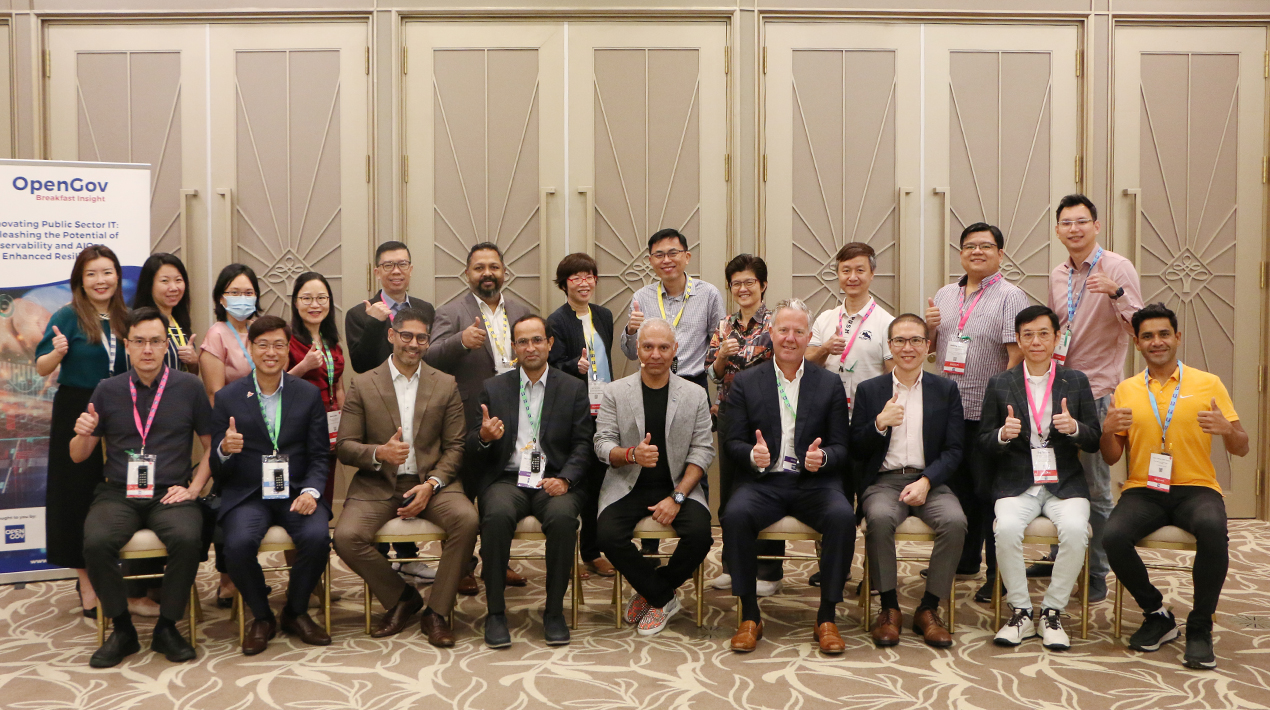
|
Getting your Trinity Audio player ready...
|
The public sector is under growing pressure to innovate and adapt in the rapidly changing digital landscape nowadays to provide effective services that are focused on the needs of citizens. Adopting cutting-edge technologies, especially observability and AIOps (Artificial Intelligence for IT Operations), which have the potential to improve resilience and accelerate digital transformation in multi-cloud systems, is essential to overcoming this difficulty.
Observability, in the context of IT, refers to the ability to comprehensively monitor and understand the various components and interactions within an IT ecosystem. It goes beyond traditional monitoring by providing real-time, end-to-end visibility into the system’s performance, pinpointing issues and bottlenecks before they impact users. This is particularly valuable in the public sector, where reliable and responsive services are paramount.
AIOps, on the other hand, represents the fusion of artificial intelligence and IT operations. By leveraging AI and machine learning, AIOps can not only monitor and analyse vast amounts of data but also predict and prevent potential IT issues. This proactive approach to IT management ensures smoother operations and minimises disruptions, ultimately leading to better outcomes for citizens.
The public sector’s journey towards digital transformation is inherently complex, often involving multi-cloud environments with a combination of on-premises and cloud-based services. Observability and AIOps serve as valuable tools in simplifying this complexity and streamlining digital initiatives.
One of the central advantages of these technologies is their ability to provide simplicity in navigating intricate IT ecosystems. By offering end-to-end visibility, observability allows IT teams to quickly identify and resolve issues, whether they originate in an on-premises server or a cloud-based application. This simplification ensures that public sector organisations can focus their efforts on improving citizen experiences rather than getting bogged down in IT management.
Security is another critical aspect of digital transformation in the public sector, where sensitive citizen data must be protected at all costs. Observability and AIOps contribute to enhanced security by continuously monitoring for anomalies and potential threats. By identifying and responding to security breaches in real-time, these technologies bolster the public sector’s defences and safeguard citizen information.
Moreover, the power of observability and AIOps extends to performance optimisation. The insights gained from these technologies enable public sector organisations to fine-tune their IT environments, ensuring that services are not only secure but also consistently high-performing. This translates into faster response times, reduced downtime, and a seamless experience for citizens accessing government services.
The OpenGov Breakfast Insight held on 16 November 2023 at the Equarius Hotel Singapore shared knowledge on how public sector organisations can gain real-time visibility across the entire IT ecosystem, enabling proactive monitoring, rapid troubleshooting, and informed decision-making to deliver uninterrupted and reliable services to citizens.
Opening Remarks

According to Mohit Sagar, Mohit Sagar, CEO and Editor-in-Chief of OpenGov Asia, Recent worldwide events have brought to the forefront the urgent requirement for government agencies to undergo transformation and embrace innovation.
Digital transformation represents the path towards providing citizens with more efficient and effective services. Consequently, achieving success in this dynamic landscape necessitates resilience, adaptability, and innovation.
In this context, the modernisation of IT infrastructure stands as a paramount priority for the public sector in today’s rapidly evolving digital age.
Mohit lays out the Four Pillars of Transformation – Modernising IT in the Digital Era; Resilience, Adaptability, and Innovation; Accelerated Need for Transformation and Innovation and Digital Transformation for Enhanced Citizen Services.
While transformation is the accepted way forward many challenges make the way forward complicated. One of the key issues encountered on this journey is the management of multi-cloud environments. Frequently, public sector organisations employ various cloud providers and services, leading to a complex IT infrastructure.
Monitoring and managing multiple tools across different clouds can be time-consuming and resource-intensive, potentially leading to data silos and hindering effective decision-making. These complexities can impede the digital transformation journey in multi-cloud environments, leading to performance issues, security vulnerabilities, and downtime.
Each cloud platform may have its set of monitoring tools and management systems, making it challenging to gain a holistic view of the entire environment. The lack of visibility can hinder proactive problem identification and resolution, ultimately impacting the overall transformation goals and citizen outcomes.
“Without comprehensive visibility of the entire infrastructure, it becomes challenging to optimise resource allocation, detect anomalies, and ensure consistent performance,” Mohit explains.
To address these challenges, cutting-edge technologies like Observability and AIOps come into play. Observability enables organisations to gain deep insights into the internal workings of complex systems by collecting, analysing, and visualising diverse data sources. AIOps (Artificial Intelligence for IT Operations) combines artificial intelligence (AI) and machine learning (ML) techniques with IT operations to automate and improve the management and performance of IT systems.
Observability provides a comprehensive view of multi-cloud environments, including infrastructure, applications, and services. It offers real-time monitoring, analytics, and visualisation of key performance indicators, allowing IT teams to quickly identify issues and take proactive measures.
AIOps utilises advanced analytics and ML algorithms to analyse large volumes of data, detect patterns, and identify anomalies or potential issues. By leveraging automation and intelligent alerting, AIOps can proactively notify IT, teams, about impending problems, enabling them to take preventive actions before they impact the citizen experience.
Mohit underscores that in the public sector, citizen services encompass a wide range of essential offerings, including healthcare, education, transportation, public safety, and social welfare. The quality and efficiency of these services directly impact citizens’ lives, well-being, and overall satisfaction. Public sector organisations strive to deliver services that are accessible, responsive, personalised, and delivered with a citizen-centric approach.
Through the implementation of Observability and AIOps, organisations can ensure timely access to data, improve application and database performance, and optimise service delivery. By proactively addressing performance issues, these technologies help reduce response times and enhance the overall user experience, ultimately leading to improved citizen services.
Public sector IT faces unique challenges due to the complexities of monitoring and managing tools in multi-cloud environments. Addressing these challenges is crucial to ensure the success of digital transformation initiatives and to provide efficient and resilient services to citizens.
Through a comprehensive IT management strategy with AIOps, public sector organisations can enhance system performance, reduce downtime, improve efficiency, and ultimately deliver better services to citizens. This approach leads to enhanced service delivery, timely issue resolution, and a citizen-centric approach.
“Leveraging Observability and AIOps allows organisations to improve visibility, streamline operations, and enhance overall performance,” Mohit concludes. “Ultimately, this will improve citizen experiences and bolster trust in government services.”
Welcome Address

Cullen Childress, Senior Vice President of Products at SolarWinds Inc, underscores the importance of resilience, adaptability, and innovation for the public sector to enhance the delivery of efficient and effective services to citizens.
In the course of their digital transformation journey, cloud technology has undoubtedly emerged as a valuable asset. It has enabled agencies and departments to streamline operations, enhance scalability, and leverage innovative solutions to meet evolving needs. However, while cloud technology offers significant advantages, it also brings forth a set of challenges that must be navigated when deploying a cloud strategy.
Public sector organisations encounter a substantial hurdle as they grapple with the expanding adoption of multi-cloud ecosystems, involving the utilisation of various cloud providers and services. Cullen underscored the intricate complexities inherent in overseeing such environments, which encompass performance considerations, security susceptibilities and the potential for operational disruptions.
For the government, a citizen-centric approach remains the central principle, prioritising the optimisation of delivery, the enhancement of accessibility and the provision of tailored experiences to elevate citizen satisfaction and foster trust in government services.
However, in the absence of a holistic view, the task of efficiently allocating resources and maintaining consistent performance becomes notably arduous, thereby impeding the realisation of transformation objectives and the enhancement of citizen outcomes.
Technology providers assume a pivotal role in crafting customised solutions tailored to the distinctive challenges encountered within the public sector. Therefore, fostering close collaboration with government agencies becomes imperative to collectively devise effective strategies that align with the sector’s specific requirements.
Furthermore, the expertise and knowledge of experts and thought leaders in the field offer invaluable contributions by furnishing insights and best practices that can better steer the course of digital transformation. Their wealth of understanding and experience are instrumental in shaping strategies and solutions for maximum effectiveness.
Similarly, the feedback and requirements of citizens serve as crucial input that guides the creation of citizen-centred solutions. By actively engaging citizens in the process, public sector organisations can ensure that the services they offer align with the needs and expectations of the individuals they serve.
Technology can catalyse substantial digital transformation within the public sector, with the potential to augment efficiency, refine service delivery, and elevate citizen outcomes but the achievement of these transformative goals mandates a collective effort involving a diverse array of stakeholders. A collective commitment ensures that technology’s potential is harnessed to amplify and simplify the management of multi-cloud environments, enhance security, and optimise operations.
Nonetheless, these collaborative efforts and initiatives are most effective when organised under the leadership and guidance of the government. Government stewardship ensures that the collective endeavours are aligned with overarching public policies, regulatory frameworks, and the specific goals of the public sector. This provides a cohesive and well-coordinated approach to address the multifaceted challenges and opportunities presented by digital transformation.
“Government agencies must lead in setting a clear vision, policies, and strategies while also ensuring the necessary resources are in place to support these initiatives,” he argues. “By adopting a citizen-centric approach and leveraging technology effectively, the public sector can adapt to the demands of the digital era, bolster resilience, and provide superior services to its citizens.”
In Conversation With

Harish Srinivasan, Deputy Chief Information Officer & Deputy Director of Information Technology Public Service Division, Prime Minister’s Office acknowledges that information technology plays a significant role in improving the quality of public services to satisfy the public.
In today’s context, information technology has paved the way for a revolution in public services, enabling the government to swiftly adapt and respond to the public’s evolving needs and preferences, ultimately enhancing the quality of the people’s interactions with these services.
An example of information technology in action is the adoption of multi-cloud environments to develop online platforms and mobile applications that render public services more accessible and efficient for the public. Harish elaborates that this approach empowers citizens to conveniently access information and engage in transactions with the government, eliminating the need for physical office visits.
Furthermore, the utilisation of online platforms and mobile applications enables the government to offer more inclusive services, extending access to various community groups, including those residing in remote areas or facing mobility challenges. In this regard, information technology plays a pivotal role in promoting equal access to public services, a cornerstone principle in contemporary democracies.
According to Harish, the adoption of information technology offers the government efficiency advantages by enabling the automation of numerous processes, leading to a substantial reduction in the time and resources needed for administrative tasks.
“This translates into cost savings for government budgets and an enhancement in operational efficiency across multiple tiers of government,” explains Harish. “The streamlined processes and reduced administrative overhead not only optimise resource allocation but also free up financial resources that can be redirected towards other crucial public initiatives, ultimately benefiting both the government and the citizens it serves.”
Moreover, the utilisation of online platforms and mobile applications heralds a profound shift in the government’s ability to collect and utilise precise, real-time data concerning the evolving needs and preferences of its citizens. This newfound capability empowers the government to craft highly tailored and responsive public service policies and programs, ushering in a new era of data-driven governance.
By seamlessly integrating digital tools into the public service landscape, the government gains an unprecedented level of insight into the intricate web of its citizens’ requirements. This dynamic data reveals not only what services are in demand but also how citizens wish to interact with their government. It captures the pulse of the public, allowing decision-makers to remain agile and responsive.
This wealth of data serves as a compass, guiding the government towards more strategic and targeted policy design. Gone are the days of one-size-fits-all approaches, replaced by a more nuanced, citizen-centric paradigm. With the ability to identify and prioritise the most pressing needs and preferences, public service policies and programmes can be finely calibrated to address specific challenges and aspirations.
The benefits of this data-driven approach are manifold, ensuring public resources are allocated with pinpoint accuracy and avoiding wastage and redundancy. It enables the government to proactively address emerging issues, rather than relying on reactive, outdated strategies. Besides, it fosters an environment of continuous improvement, where policies are subject to ongoing refinement based on the evolving data landscape.
Harish underscored that this data-driven decision-making process is not limited to the realm of service delivery. It extends to the very core of governance, infusing transparency, accountability, and responsiveness into the public sector.
“By tailoring policies and programmes to citizens’ ever-changing preferences and needs, the government can enhance its credibility and effectiveness,” he is convinced.

Cullen Childress, Senior Vice President of Products at SolarWinds Inc acknowledges that modernising Information Technology is a top priority for all levels of government. In today’s rapidly developing era, resilience, adaptability and innovation are the keys to success that must be achieved together.
Governments need to have the ability to adapt quickly to technological developments, increasingly complex security threats, and the ever-changing demands of society. Information Technology Modernisation is not just an option, but a necessity to ensure more efficient, safe and innovative public services.
“By understanding the importance of Information Technology modernisation as a top priority, governments can position themselves at the forefront of change, build strong foundations for a challenging future, and produce better outcomes for the communities they serve,” he explains.
Leaders in Information Technology now more than ever need cutting-edge technologies to ensure that all data and information can be accessed in real-time. This is not only a necessity, but also the key to maintaining smooth operations and supporting better decision-making.
Equally important, in the context of public sector computing environments, which often have very specific demands, the same depth and breadth in terms of visibility and functionality is required. This is becoming increasingly important to ensure systems run smoothly and achieve peak performance, which in turn will provide real benefits to the communities served by the organisation. That is why public sector organisations are also required to have access to the latest technologies to answer complex challenges in the future.
Cullen underscores that policymakers can effectively preempt the challenges faced along the transformation journey by following specific steps. Firstly, by commencing with a thorough risk assessment to identify potential vulnerabilities and areas of concern. Secondly, by allocating resources towards data analytics and monitoring tools capable of continuously evaluating application and system performance, providing insights for proactive management. Thirdly, by integrating an automated alert system that can promptly notify the team of any unusual limitations or irregularities, facilitating swift problem identification and resolution.
SolarWinds offers solutions that include a variety of tools and technologies to help organisations proactively identify and resolve problems. With an approach focused on comprehensive risk evaluation, real-time data analytics, and automated alert systems, SolarWinds provides IT policymakers with the tools they need to improve citizen experiences and secure their applications.
By investing in these advanced technologies, organisations can meet the complex challenges that arise in an ever-changing information technology environment and ensure that problems can be identified and addressed promptly before they negatively impact public services and application security. SolarWinds is committed to helping technology leaders and policymakers achieve these goals and deliver effective solutions.
To achieve the vision of better and more satisfying public services, wise and safe use of information technology is a must. With the right efforts, information technology can continue to be a powerful tool in improving relations between government and society, as well as in advancing the quality of public services.
Closing Remarks
Cullen expressed his sincere appreciation to the attendees, underlining that the forum serves as more than just a platform for knowledge exchange and sharing experiences; it serves as a catalyst for nurturing robust networks and fostering collaboration within this community.
 Through the active involvement and assistance of technology practitioners, organisations can successfully tackle intricate challenges in the realm of information technology, fostering an environment where collective efforts lead to the accomplishment of common goals and the attainment of mutual success.
Through the active involvement and assistance of technology practitioners, organisations can successfully tackle intricate challenges in the realm of information technology, fostering an environment where collective efforts lead to the accomplishment of common goals and the attainment of mutual success.
In a swiftly changing world marked by rapid technological advancements and shifts in the business landscape, data has become a crucial component in maintaining accuracy and speed in decision-making. It plays a pivotal role in ensuring that decisions remain precise and timely.
Against this backdrop, the pivotal role of statistics in expediting decision-making processes cannot be understated. Data serves not only as an informational resource but also as the fundamental building block for uncovering patterns, identifying opportunities, and surmounting obstacles through in-depth analysis and insights.
Cullen firmly believes that the availability of pertinent and current data empowers leaders and decision-makers to promptly adapt to evolving circumstances, enabling them to craft more flexible and responsive strategies. This, in turn, facilitates the delivery of improved and tailored services to the community, as decision-makers are equipped with the insights needed to make informed choices that cater to the ever-changing needs of the people they serve.
Mohit points out that technological partnerships offer a wide range of advantages, from accessing expertise and driving innovation to cost efficiency and competitive advantage. He suggests that in an increasingly interconnected world, these collaborations are becoming essential for organisations looking to thrive and succeed in the digital age.
Data, he acknowledges, opens the door for continuous innovation. By carefully analysing data, organisations can identify opportunities to develop new products or services, improve operational efficiency and create added value. Hence, it is vital for organisations to maintain a solid understanding of the key role that data plays in digital transformation.
Moreover, it is also crucial to prioritise securing access to data, fostering a comprehensive understanding of its nuances, and establishing the necessary infrastructure that empowers organisations to harness their full potential when making informed decisions.
“The emphasis placed on data is far from being a mere option; it constitutes an indispensable cornerstone for achieving success in our increasingly digitalised landscape. Data is what powers informed choices and unlocks the door to opportunities,” Mohit concludes. “It is an integral element for staying competitive and attaining excellence in the contemporary business and technological environment.”
















